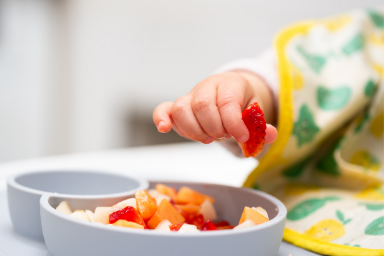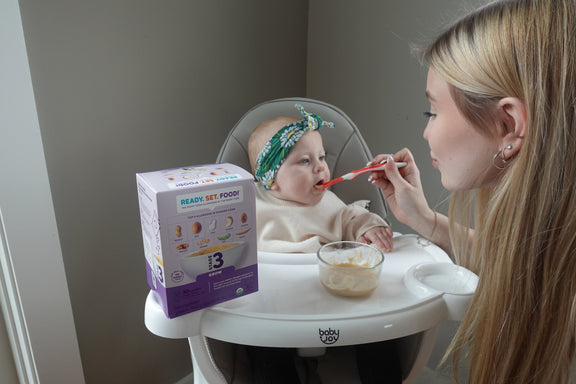Protein supports your toddler’s growth, helps build strong bones and muscles, and promotes a healthy immune system. But how to know if your toddler is getting enough protein, and what options are there to feed your toddler a variety of protein foods? Find out in this guide.
Protein is a vital nutrient for your little one’s growth and development. It helps your toddler build strong bones and muscles. It also boosts their immune system, by powering the cells that fight against harmful bacteria and viruses. Plus, protein helps repair the body's tissues (including muscle tissue), and is vital for the overall maintenance and healthy growth of the body.
But how to know if your toddler is getting enough protein? And what are some ways to feed your toddler protein as part of a varied, balanced diet? We’ve got you covered.
How much protein does a toddler need?
Toddlers 1-3 years of age need at least 13-17 grams of protein per day. The exact amount they need depends on their weight – they need around 0.55 grams of protein per day for every pound they weigh. But regardless of their weight, 13 grams is the minimum recommended amount for 1-3 year old toddlers.
The best protein-packed foods for toddlers
Meat and fish aren’t the only way for your toddler to get protein. Eggs, dairy foods, and whole grains are also great protein-packed foods. So are members of the legume family – like beans, peas, lentils, and toddler-safe forms of peanut.
Mix and match any of the below protein-packed choices each day, as part of feeding your toddler a nutritious diet.
Here are the protein amounts in some of the best protein-packed foods for toddlers:
- An average sized egg contains 6-7 grams protein
- 8 ounces of cow’s milk (= 1 cup) contains about 8 grams protein
- ½ cup yogurt has 4-5 grams protein
- 1 ounce cheese contains around 7 grams protein
- ½ cup red beans or black beans supplies about 8 grams protein
- ½ cup peas contains 4 grams protein
- ½ cup lentils supplies around 9 grams protein
- 1 tablespoon smooth peanut butter (watered down) has about 4 grams protein
- 1 ounce chicken has about 8 grams protein
- 1 ounce lean beef has about 7 grams protein
- 1 ounce Atlantic salmon (a low-mercury fish) supplies 6 grams protein
- 1 ounce whole-wheat pasta contains 4 grams protein
- ½ cup cooked quinoa supplies around 4 grams protein
- 3 ounces tofu contains about 7 grams protein
- A serving of Ready. Set. Food! Organic Baby Oatmeal contains 4-5 grams protein (depending on the flavor)
- 1 Ready. Set. Food! Organic Oat & Fruit Bar contains 3 grams protein
What does 13-17 grams of protein per day look like?
Toddler servings of protein may be a bit less than the amounts of protein-packed foods listed above. Still, it’s easier to give your toddler 13-17 grams of daily protein than you might think, and you have plenty of options to do so.
Recommended toddler serving sizes for protein foods are:
- 1 ounce meat or fish
- Half an egg
- ⅓ to ½ cup yogurt
- ½ cup milk
- 2-3 tablespoons whole-grain pasta
- 2-3 tablespoons beans, peas, or lentils
- 2 tablespoons ground lean meat
- 2 tablespoons tofu
This means that feeding 4-5 small toddler servings of eggs, dairy, legumes, and/or whole grains per day (or 3-4 servings of these foods plus a serving of meat, fish, or tofu) will give your toddler enough daily protein.
It’s also important to point out that toddlers should be drinking around 2 cups of milk per day, or getting the equivalent of 2 cups of milk from both milk and other dairy foods. And 2 cups of milk supply 16 grams of protein by themselves.
But don’t worry if your toddler gets over 17 grams of protein in a day, as long as they’re eating a healthy diet overall (with a variety of protein foods, and plenty of fruits and veggies to go along with the proteins). Most toddlers consume more than 17 grams of protein in a day.
The recommended range of daily protein intake for a toddler age 1-3 years is 5% to 20% of their calories. That means 5% to 20% of their calories each day should come from proteins.
Is there such a thing as too much protein?
According to experts, the maximum amount of protein a toddler should eat in a day is 20% of their calories.
For instance, a toddler eating 1000 calories should have a maximum of 50 grams of protein per day. And for a toddler eating 1200 calories, this means that they should have a maximum of 60 grams of protein per day.
Don’t sweat it – if your toddler is eating a nutritious, varied diet, they will get enough protein, and they shouldn’t end up eating too much.
Varying the protein foods you give
It’s most important to vary the protein foods you give your toddler – your toddler needs to get their protein from more than just dairy.
According to the United States Department of Agriculture (USDA) Dietary Guidelines, 1 year olds should have 2 cups of dairy each day, plus 2 ounces of whole grains and 2 ounces of other protein foods daily. (“Other protein foods” include meat, eggs, seafood, nuts, seeds, and/or soy).
2-3 year olds should have 2-2 ½ cups of dairy each day, plus 1 ½ to 2 ounces of whole grains and 2-4 ounces of other protein foods daily.
The USDA Dietary Guidelines also recommend feeding a variety of protein foods each week.
For a 1-year-old toddler who is eating 900 calories per day, the guidelines recommend:
- 7 total ounces of meat and poultry each week
- 2 ½ ounces of eggs each week
- 2-3 ounces of seafood each week
- ½ cup beans, peas, and/or lentils each week
- 1 ¼ ounces of toddler-safe nut, seed, and soy products each week
For a 1-year-old toddler who is eating 1,000 calories per day, the guidelines recommend:
- 7 ¾ total ounces of meat and poultry each week
- 2 ½ ounces of eggs each week
- 2-3 ounces of seafood each week
- ½ cup beans, peas, and/or lentils each week
- 1 ¼ ounces of toddler-safe nut, seed, and soy products each week
For a toddler age 2-3 years who is eating 1,000 calories per day, the guidelines recommend:
- 10 total ounces of meat, poultry, and eggs each week
- 2-3 ounces of seafood each week
- ½ cup beans, peas, and/or lentils each week
- 2 ounces of toddler-safe nut products, seeds, and soy products each week
For a toddler age 2-3 years who is eating 1,200 calories per day, the guidelines recommend:
- 14 total ounces of meat, poultry, and eggs each week
- 4 ounces of seafood each week
- ½ cup beans, peas, and/or lentils each week
- 2 ounces of toddler-safe nut products, seeds, and soy products each week
For a toddler age 2-3 years who is eating 1,400 calories per day, the guidelines recommend:
- 19 total ounces of meat, poultry, and eggs each week
- 6 ounces of seafood each week
- ½ cup beans, peas, and/or lentils each week
- 3 ounces of toddler-safe nut products, seeds, and soy products each week
Ready. Set. Food!: A great source of protein in a diverse diet
Ready. Set. Food! Organic Baby Oatmeal and Organic Oat & Fruit Bars are great sources of protein, and an excellent way to help diversify your toddler’s diet.
Our Organic Baby Oatmeal contains 9 top allergens, and our Organic Oat & Fruit Bars contain 8 top allergens, to help sustain your toddler’s exposure to these foods as part of a nutritious, diverse diet.
A serving of Ready. Set. Food! Organic Baby Oatmeal contains 4-5 grams protein, and one Ready. Set. Food! Organic Oat & Fruit Bar contains 3 grams protein. Plus, they’re both great sources of iron as well.

The Window Of Opportunity For Introducing Peanut: New Study Findings From the LEAP and EAT Trials
Results from the landmark LEAP and EAT studies have shown that intr...

Best Finger Foods For Babies (And When To Start Finger Foods)
When to move beyond the spoon and start baby's journey with finger ...

6 Reasons Why You Should Introduce Allergens
Landmark studies and medical guidelines recommend that you introduc...

7 Ways to Feed Your Toddler More Iron
Iron is an essential mineral for your toddler’s brain health and ov...

How Much Milk Should Your Toddler Drink?
How much milk should your toddler drink in a day? Find out the reco...
All health-related content on this website is for informational purposes only and does not create a doctor-patient relationship. Always seek the advice of your own pediatrician in connection with any questions regarding your baby’s health.
These statements have not been evaluated by the Food and Drug Administration. Products are not intended to diagnose, treat, cure or prevent any disease. If your infant has severe eczema, check with your infant’s healthcare provider before feeding foods containing ground peanuts.







